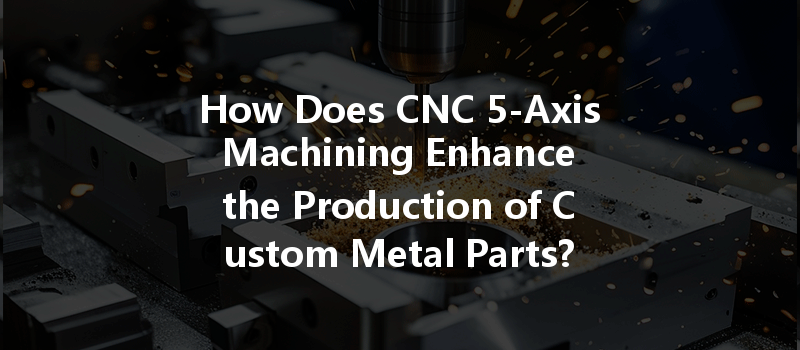Did you know that 5-axis CNC machining can reduce manufacturing time by up to 75% compared to traditional 3-axis machining? This impressive statistic underscores the transformative power of advanced CNC machining techniques in the production of custom metal parts. As industries across the globe face increasing demands for precision, efficiency, and versatility, 5-axis CNC machining has emerged as a game-changer.
In this blog, we will explore the intricacies of CNC 5-axis machining, its benefits, the technology behind it, applications in various industries, and how it enhances the production of custom metal parts. By the end of this post, you’ll have a comprehensive understanding of why this technology is pivotal in today’s manufacturing landscape and how it can solve many of the challenges faced in producing high-quality custom metal components.
Chapter 1: Understanding CNC Machining
Before delving into the specifics of 5-axis machining, it’s essential to understand the broader concept of CNC (Computer Numerical Control) machining. CNC machining is a process that automates the control of machining tools via numerical control. It eliminates the need for manual operation, improving accuracy and efficiency.
1.1 Basics of CNC Machining
CNC machining works by transforming design files, usually created using CAD (Computer-Aided Design) software, into machine-readable code. This code controls the movement of various machine components – including a spindle that rotates the cutting tool, and motors that move the workpiece. The flexibility of CNC machines enables manufacturers to produce complex shapes and designs with high precision.
1.2 Types of CNC Machining
The most common types of CNC machining processes include:
While traditional 3-axis machines are widely used, we will focus on the advanced capabilities of 5-axis machining.
Chapter 2: The Evolution to 5-Axis Machining
2.1 What is 5-Axis CNC Machining?
5-axis CNC machining expands on the capabilities of its 3-axis counterpart by allowing the cutting tool to move along five different axes: three linear axes (X, Y, Z) and two rotational axes (A, B). This means the machine can make more complex cuts without needing to reposition the workpiece, drastically improving accuracy and reducing machining time.
2.2 Benefits of 5-Axis Machining
Chapter 3: Key Components of 5-Axis CNC Machines
Understanding the intricacies of 5-axis CNC machines requires familiarity with their components:
3.1 Machine Structure
5-axis CNC machining centers typically consist of a base, a column, a table, and a spindle. The spindle can be oriented at various angles, enabling the machining of complex features.
3.2 Software
CNC programming software is crucial for converting CAD files into machine language. Advanced CAM (Computer-Aided Manufacturing) software can also simulate the machining process to verify tool paths and prevent collisions.
Chapter 4: Applications of 5-Axis CNC Machining in Custom Metal Parts
The versatility of 5-axis CNC machining makes it an invaluable asset in various sectors:

4.1 Aerospace Manufacturing
In aerospace, components must meet strict safety and performance standards. 5-axis machining allows manufacturers to create lightweight, yet strong parts such as brackets and mounts with intricate geometries while adhering to tight tolerances.
4.2 Automotive Industry
For the automotive sector, 5-axis machining can produce custom parts like engine components, transmission housings, and molds for injection molding. Reducing weight without compromising strength is crucial to enhance fuel efficiency.
4.3 Medical Devices
Custom-made medical instruments and devices require high precision, particularly where patient safety is involved. 5-axis machining can forge complex shapes that are often needed in surgical instruments while maintaining high sterility criteria.
4.4 Industrial Equipment
5-axis CNC machining allows for the production of components for industrial machinery, achieving the necessary tolerances and surface finishes required for optimal equipment performance.
Chapter 5: Overcoming Challenges in Custom Metal Parts Production
Despite its advantages, there are challenges associated with 5-axis CNC machining, including:
5.1 Initial Costs
The investment in 5-axis CNC machines and the necessary software can be significant. However, when considering the long-term benefits of reduced production time and increased efficiency, these costs can often be justified.
5.2 Complexity of Programming
Programming a 5-axis CNC machine can be more complicated than 3-axis machines. Manufacturers must invest in skilled labor and training to ensure correct operations.
5.3 Maintenance Requirements
Maintaining the precision and accuracy of complex machines like the 5-axis CNC requires regular upkeep, which can add to operational costs.
Chapter 6: Best Practices for Using 5-Axis Machining
To maximize the benefits of 5-axis CNC machining, consider implementing the following best practices:
6.1 Invest in Quality Tools
Utilizing high-quality cutting tools specifically designed for 5-axis machining can enhance surface finish and longevity.
6.2 Optimize Tool Paths
Using advanced CAM software for optimizing tool paths can significantly reduce machining time and improve part accuracy.
6.3 Continuous Training
Regular training and upskilling of employees are crucial for ensuring they can effectively operate and maintain the machinery, thus reducing operation errors.
Chapter 7:
In conclusion, CNC 5-axis machining is a revolutionary technology that enhances the production of custom metal parts by offering unparalleled precision, efficiency, and versatility. From aerospace manufacturing to medical device production, the benefits are clear: reduced lead times, improved surface finish, and the ability to manufacture complex components that meet industry-specific requirements.
As industries continue evolving, embracing modern technologies will help maintain competitiveness. Understanding and implementing 5-axis CNC machining can greatly enhance your production capabilities and operational efficiency.
As we look toward the future, consider the potential of 5-axis machining not just as a tool, but as a solution to the challenges faced in manufacturing custom metal components. The journey into this technology promises not just enhancements in production capabilities, but also opens doors to innovation and creativity in design—ensuring your products meet the ever-increasing demands of quality and performance.
Embrace the potential of CNC 5-axis machining in your operations—because staying ahead is not just about keeping pace; it’s about leading the way in innovation.






